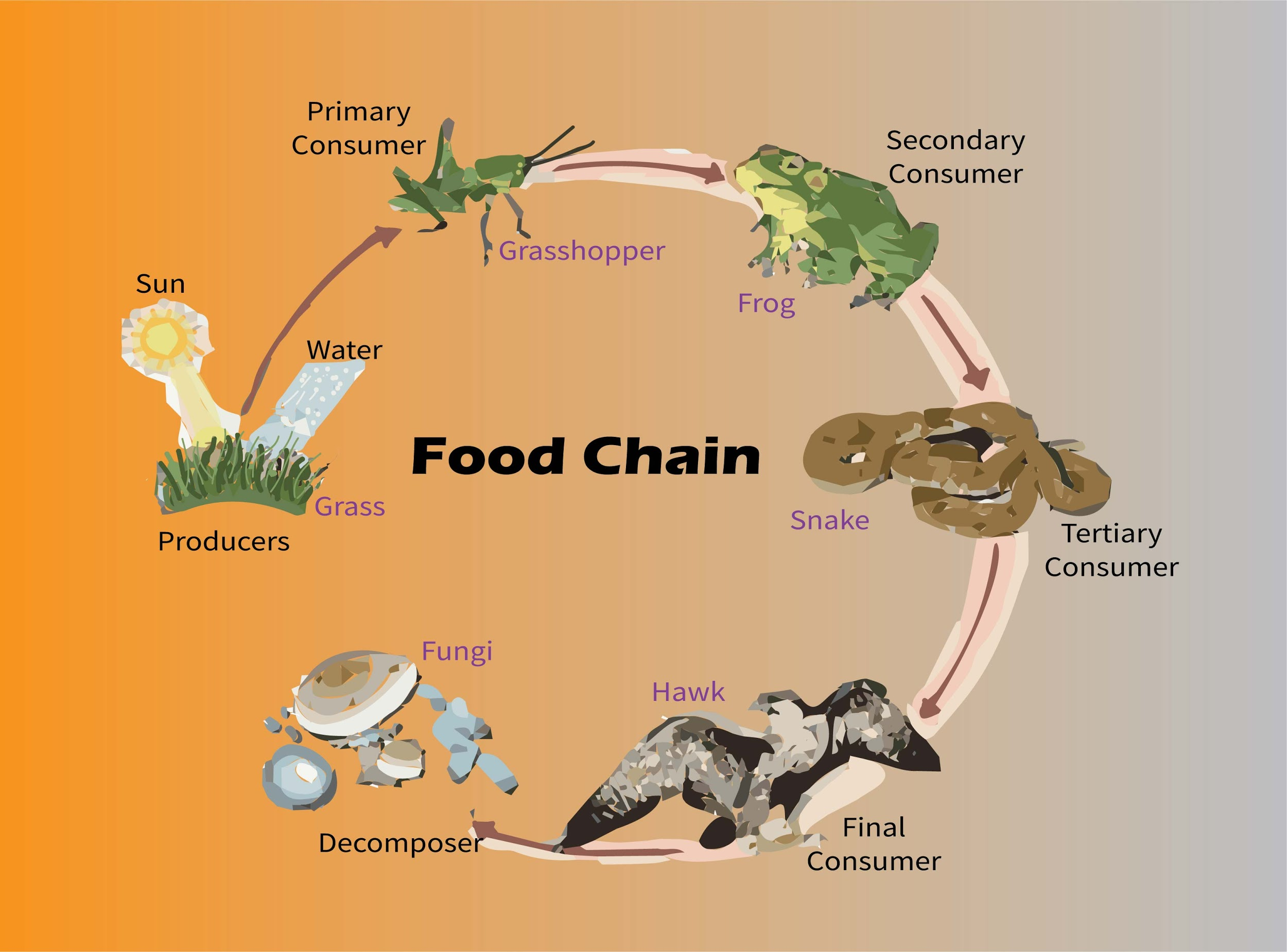
In the given food chain who gets less energy than the tertiary Consumer?
Grass⟶Grasshopper⟶Frog⟶Snake⟶Eagle
(a)Grasshopper
(b)Frog
(c)Snake
(d)Eagle
Answer
471.9k+ views
Hint: In an ecosystem, a series of organisms each organism dependent on the feeding of the next as a source of food is known as a food chain. It shows how the organisms are related to each other and each level of a food chain signifies a divergent trophic level.
Complete answer:
In a food chain, consumers are categorized into three groups: primary consumers, secondary consumers, and tertiary consumers. Primary consumers are herbivores, feeding on plants and fungus. Secondary consumers are carnivores, who feed on other animals. Tertiary consumers are usually at the top of food chains, capable of feeding on secondary consumers and primary consumers. According to the ten per cent law, exactly 90% of the energy is lost in the transfer at each trophic level, and only 10% is passed on as usable biological energy. Here, the eagle is at the top of the food chain and the snake is the tertiary consumer.
Additional Information: One of the ways for an ecosystem to work at its fullest is that there has to be a flow of energy. The energy is achieved in the form of food in the ecosystem. The topmost source of this energy is the sun and producers like green plants trap solar energy to convert it into the chemical energy for getting their food. A part of this energy is passed on to producers now. The primary producer is then eaten by the primary consumer; this is again eaten by a secondary consumer. This secondary consumer may be eaten by a tertiary consumer, and so on. The energy gets carried from one consumer to the next higher level of consumer. The food chain is made up of this link from producers and ending at apex predator species or decomposer species. A food chain in a grassland ecosystem starts with grass being the primary producer by trapping energy from sunlight. Insects like grasshoppers are primary consumers because they directly depend on the green plant for their food. The frog is the secondary consumer because it eats insects. The snake is a tertiary consumer and feeds on frogs for its food.
So, the correct answer is,’ Eagle.’
Note: -An ecological pyramid is a graphical representation to show the relationship between different organisms in an ecosystem and each of the bars that make up the pyramid represents a different trophic level.
-Ecological pyramids are generally of three types: the pyramid of the number, the pyramid of biomass, and the pyramid of energy (showing the rate of energy flow).

Complete answer:
In a food chain, consumers are categorized into three groups: primary consumers, secondary consumers, and tertiary consumers. Primary consumers are herbivores, feeding on plants and fungus. Secondary consumers are carnivores, who feed on other animals. Tertiary consumers are usually at the top of food chains, capable of feeding on secondary consumers and primary consumers. According to the ten per cent law, exactly 90% of the energy is lost in the transfer at each trophic level, and only 10% is passed on as usable biological energy. Here, the eagle is at the top of the food chain and the snake is the tertiary consumer.
Additional Information: One of the ways for an ecosystem to work at its fullest is that there has to be a flow of energy. The energy is achieved in the form of food in the ecosystem. The topmost source of this energy is the sun and producers like green plants trap solar energy to convert it into the chemical energy for getting their food. A part of this energy is passed on to producers now. The primary producer is then eaten by the primary consumer; this is again eaten by a secondary consumer. This secondary consumer may be eaten by a tertiary consumer, and so on. The energy gets carried from one consumer to the next higher level of consumer. The food chain is made up of this link from producers and ending at apex predator species or decomposer species. A food chain in a grassland ecosystem starts with grass being the primary producer by trapping energy from sunlight. Insects like grasshoppers are primary consumers because they directly depend on the green plant for their food. The frog is the secondary consumer because it eats insects. The snake is a tertiary consumer and feeds on frogs for its food.
So, the correct answer is,’ Eagle.’
Note: -An ecological pyramid is a graphical representation to show the relationship between different organisms in an ecosystem and each of the bars that make up the pyramid represents a different trophic level.
-Ecological pyramids are generally of three types: the pyramid of the number, the pyramid of biomass, and the pyramid of energy (showing the rate of energy flow).

Recently Updated Pages
Basicity of sulphurous acid and sulphuric acid are

Master Class 12 Economics: Engaging Questions & Answers for Success

Master Class 12 Maths: Engaging Questions & Answers for Success

Master Class 12 Biology: Engaging Questions & Answers for Success

Master Class 12 Physics: Engaging Questions & Answers for Success

Master Class 12 Business Studies: Engaging Questions & Answers for Success

Trending doubts
Which are the Top 10 Largest Countries of the World?

Draw a labelled sketch of the human eye class 12 physics CBSE

Differentiate between homogeneous and heterogeneous class 12 chemistry CBSE

What is a transformer Explain the principle construction class 12 physics CBSE

What are the major means of transport Explain each class 12 social science CBSE

What is the Full Form of PVC, PET, HDPE, LDPE, PP and PS ?




